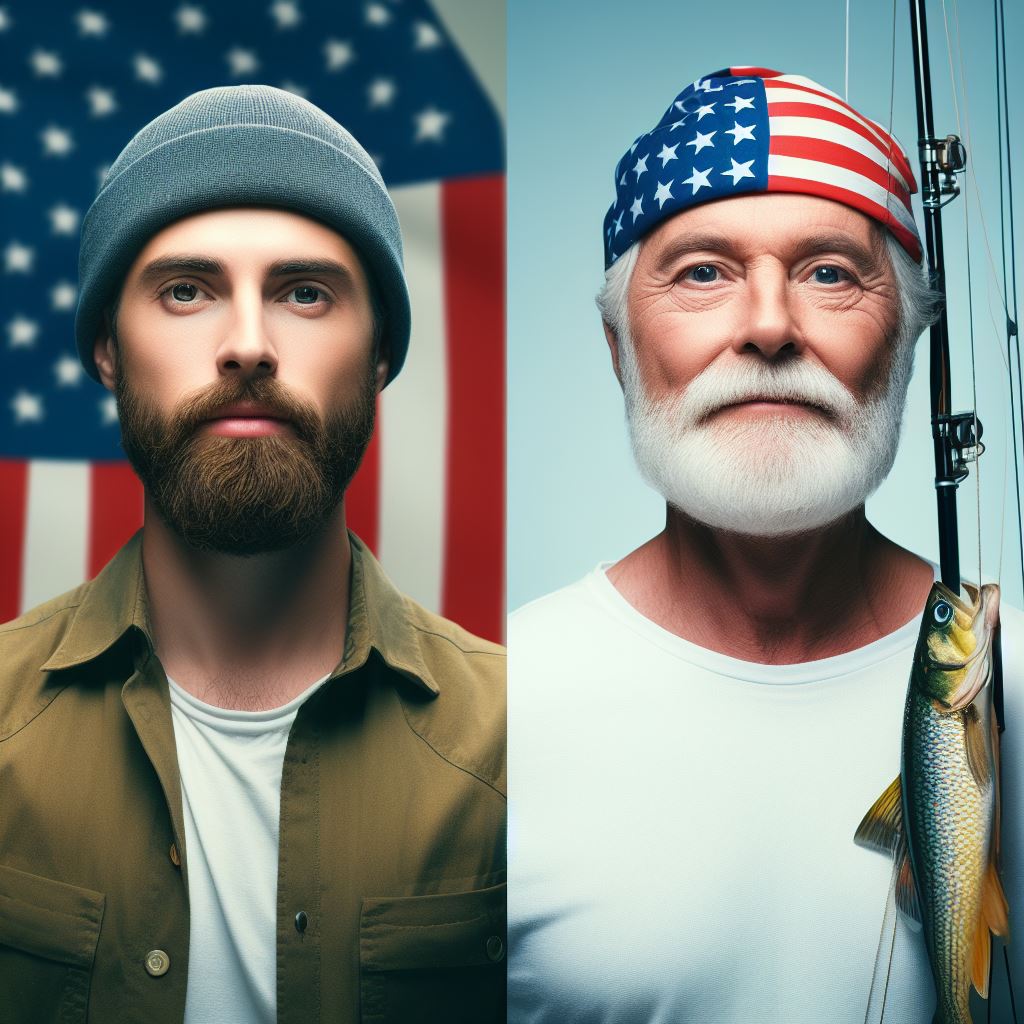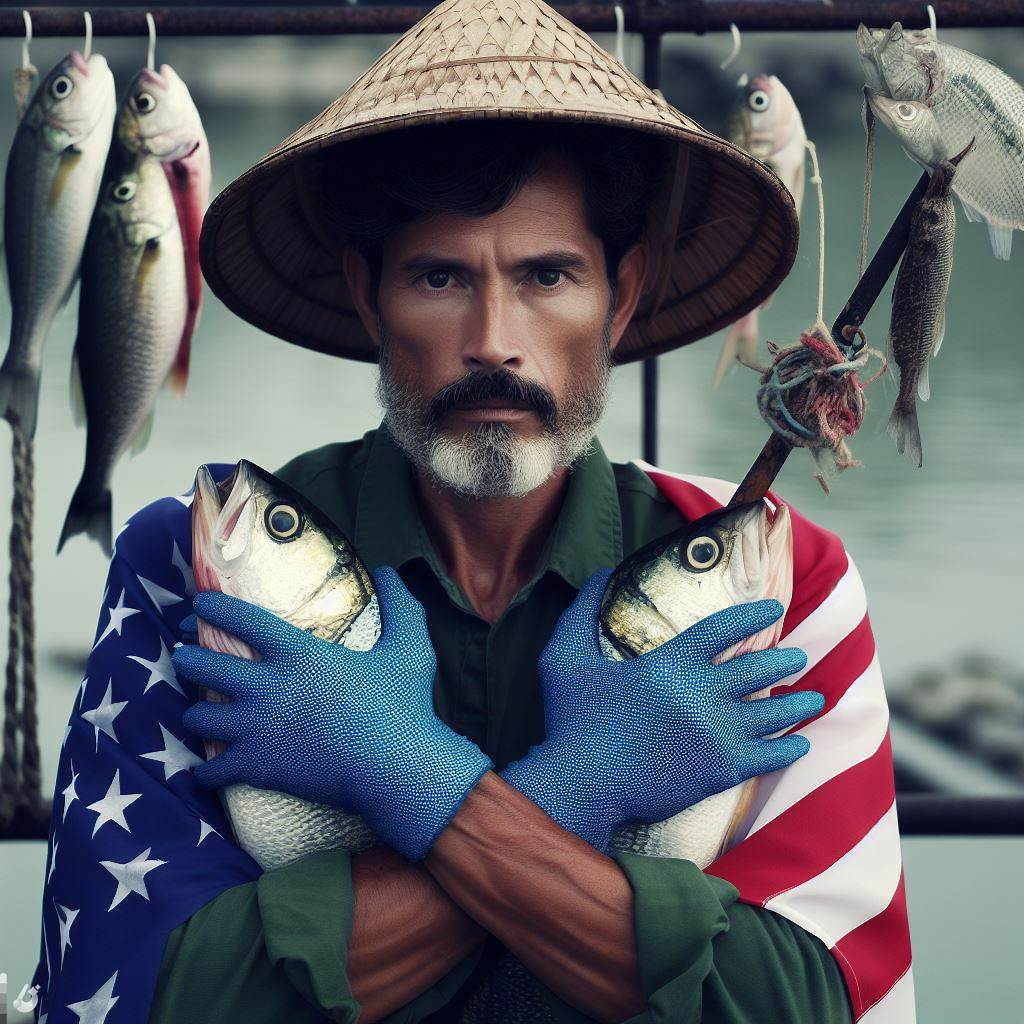Introduction
Let’s explore the Challenges Faced by Modern-Day Fishermen in this blog Section.
The fishing industry in America is crucial to the economy and food supply. Fishermen play a vital role in providing seafood to the nation.
In the rhythmic dance between man and the mighty oceans, American fishermen find themselves entangled in a web of challenges that test their resilience and resourcefulness.
The once romanticized image of fishermen battling the elements to bring home the day’s catch has evolved into a complex narrative of survival against numerous odds.
In the 21st century, these guardians of the sea face a myriad of challenges that stretch from environmental concerns to economic uncertainties.
As we delve into the world of modern-day American fishermen, the waves of change become evident – from overfishing and climate-induced shifts in marine ecosystems to the labyrinth of regulations that dictate their every move.
This blog series will unravel the tales of these unsung heroes, shedding light on the struggles that threaten not only their livelihoods but also the delicate balance of our marine ecosystems.
Join us on a journey through the tumultuous waters where tradition clashes with contemporary challenges, revealing the untold stories of those who brave the depths in pursuit of sustenance and survival.
Decline in Fish Stocks
Explanation of overfishing and its consequences
Overfishing refers to the practice of catching fish at a rate that exceeds their natural reproduction, leading to a decline in fish populations.
This is primarily driven by the increasing demand for fish products.
- Uncontrolled fishing disrupts the delicate balance of marine ecosystems, resulting in the depletion of certain fish species.
- As fish populations decline, it disrupts the food chain, affecting other marine organisms dependent on them.
- Overfishing also destroys habitats like coral reefs and seafloor communities, leading to the loss of biodiversity.
- Damaged ecosystems are less resilient to environmental changes, making them susceptible to further decline.
Impact on modern-day fishermen
The decline in fish stocks poses significant challenges for modern-day fishermen in America.
- Reduced fish populations make it harder for fishermen to catch an adequate amount to sustain their businesses and livelihoods.
- As fish stocks decline, fishermen are forced to travel longer distances and spend more time at sea, increasing their expenses and reducing profitability.
- Unavailability of certain fish species affects market demand, making it harder for fishermen to sell their catch at a reasonable price.
- The decline in fish stocks creates uncertainty about the future of fishing industries, leading to job insecurity for fishermen.
Need for sustainable fishing practices
To address the challenges faced by modern-day fishermen and conserve fish stocks, sustainable fishing practices are essential.
- Implementing fishing quotas and catch limits helps prevent overfishing and allows fish populations to recover.
- Using selective fishing gear and techniques minimizes the capture of non-target species, reducing bycatch and preserving biodiversity.
- Creating marine protected areas safeguards essential habitats and provides safe breeding grounds for fish.
- Encouraging responsible consumer choices, such as supporting certified sustainable fisheries, promotes sustainable fishing practices.
Overall, the decline in fish stocks is a critical issue affecting modern-day fishermen in America.
It not only threatens their livelihoods but also endangers marine ecosystems and biodiversity.
Adopting sustainable fishing practices is crucial to ensure the long-term viability of fishing industries and the preservation of fish populations for future generations.
Environmental Factors
Climate change and its effects on fish migration patterns
- Rising temperatures due to climate change disrupt fish migration patterns, impacting the livelihoods of fishermen.
- Fish tend to migrate towards cooler waters, making it difficult for fishermen to locate and catch them.
- Changes in water temperature and ocean currents result in shifts in fish populations, reducing catch sizes.
- Unpredictable weather patterns caused by climate change make it challenging for fishermen to plan their fishing trips effectively.
- Extreme weather events, such as hurricanes and storms, destroy fishing equipment and infrastructure, causing financial losses.
Impacts of pollution and habitat degradation on fish populations
- Pollution from industrial and agricultural activities contaminates water bodies, negatively affecting fish populations.
- Toxins and pollutants in the water are absorbed by fish, making them unsafe for consumption or stunning their growth.
- Habitat degradation, caused by human activities like deforestation and urbanization, reduces the availability of suitable breeding grounds for fish.
- Destruction of coral reefs and seafloor habitats due to pollution and human interference disrupts fish habitats.
- Overfishing combined with habitat degradation leads to a decline in fish populations, limiting the catch potential for fishermen.
Increased competition with invasive species
- Invasive species, introduced into non-native ecosystems, outcompete and prey on native fish species.
- Invasive species reproduce rapidly, altering the food web and reducing the abundance of native fish.
- Non-native predators, such as lionfish and snakehead, pose a threat to commercially valuable fish species.
- Increased competition for resources between native and invasive species lowers the overall fish yield for fishermen.
- Control and eradication of invasive species require additional efforts and resources, further burdening fishermen.
Basically, modern-day fishermen in America face significant challenges stemming from environmental factors.
Climate change disrupts fish migration patterns and reduces catch sizes.
Pollution and habitat degradation impact fish populations negatively.
Increased competition with invasive species further decreases available fish resources.
These factors make it difficult for fishermen to sustain their livelihoods and contribute to the overall decline of fish populations.
Transform Your Career Today
Unlock a personalized career strategy that drives real results. Get tailored advice and a roadmap designed just for you.
Start NowAddressing these challenges necessitates collective efforts and sustainable fishing practices to ensure the future viability of the fishing industry.
Read: Understanding the Licensing System for US Fishermen
Government Regulations
Overview of current fishing regulations in America
- The government has implemented various fishing regulations to manage and conserve fish populations.
- These regulations include size and bag limits, restricted fishing areas, and season closures.
- They aim to ensure sustainable fishing practices and prevent overfishing.
- Regulations also exist to protect endangered species and preserve the ecosystem.
- Fishermen are required to obtain licenses and permits to engage in commercial fishing activities.
Challenges faced by fishermen in complying with regulations
- Complying with fishing regulations can be complex and overwhelming for fishermen.
- Understanding the different rules and regulations applicable to specific fishing grounds can be challenging.
- Monitoring catch limits and ensuring compliance with size restrictions requires constant vigilance.
- Fishermen may face difficulties in accurately measuring and documenting their catches.
- Enforcement of fishing regulations can be inconsistent, leading to perceived unfairness among fishermen.
Balancing environmental conservation with economic needs
- The government faces the challenge of finding a balance between environmental conservation and economic needs.
- Strict regulations may result in reduced fishing opportunities and economic hardship for fishermen.
- Many fishermen rely on fishing as their livelihood, and excessive restrictions can threaten their income.
- However, failing to implement adequate regulations can lead to the depletion of fish stocks and long-term damage to the ecosystem.
- Efforts are being made to involve fishermen in the decision-making process to ensure their concerns are considered.
- Alternative measures, such as implementing fishing quotas, can help achieve a sustainable balance.
In review, government regulations play a vital role in ensuring sustainable fishing practices and maintaining the health of fish populations and the ecosystem.
While complying with these regulations can be challenging for fishermen, it is necessary to prevent overfishing and protect endangered species.
The government must find a balance between conservation and economic needs to support fishermen while ensuring the long-term sustainability of fishing resources.

Technological Advancements
Introduction of advanced fishing techniques and equipment
- New tools and equipment such as sonar and GPS have revolutionized the way fishermen locate fish.
- High-tech gear like underwater cameras and fish finders provide real-time information, improving catch rates.
- Fishermen now have access to advanced net designs, which reduce bycatch and protect the marine ecosystem.
- Modern fishing vessels are equipped with state-of-the-art navigation systems and advanced communication devices.
- Technological advancements have also led to the development of more efficient and environmentally friendly fishing gear.
How technology has transformed the fishing industry
- Automation has made certain tasks more efficient, such as the processing and packaging of seafood products.
- Advancements in refrigeration and storage systems enable fishermen to preserve their catches for longer periods.
- Online platforms and digital marketplaces have made it easier for fishermen to sell their products directly to consumers.
- Real-time weather and oceanographic data allow fishermen to make informed decisions about when and where to fish.
- Technology has also improved safety at sea, with devices like personal locator beacons and emergency communication systems.
Integration of modern tools and its impact on traditional fishing methods
- Traditional fishing practices have been influenced by the introduction of modern tools and techniques.
- Some fishermen have embraced new technology, integrating it into their traditional fishing methods.
- For example, traditional hand line fishermen now use electronic bite indicators to improve their catch rates.
- However, the use of advanced tools has also led to a decline in traditional fishing skills and knowledge.
- Younger generations of fishermen may rely heavily on technology and lack the expertise to fish using traditional methods.
On a final note, technological advancements have had a profound impact on modern-day fishermen in America.
The introduction of advanced fishing techniques and equipment has revolutionized the industry, improving efficiency, safety, and sustainability.
However, the integration of modern tools has also led to the decline of traditional fishing methods and skills.
It is crucial for the fishing industry to strike a balance between embracing new technology and preserving the rich heritage of traditional fishing practices.
Read: Technological Advancements in US Fishing Industry
Economic Challenges
Fluctuating fish prices and market demand
- Fishermen often struggle with the volatility in fish prices caused by changes in market demand.
- Sudden shifts in consumer preferences or trends can significantly impact the price that fishermen receive for their catch.
- These fluctuations make it difficult for fishermen to predict and plan their income, leading to financial instability.
Competition from imported seafood
- Modern-day fishermen in America face tough competition from imported seafood, which affects their market share.
- Imported seafood, often produced at a lower cost, poses a challenge for domestic fishermen to maintain profitability.
- Consumers sometimes prioritize cheaper imported options due to price, further impacting the livelihood of fishermen.
Economic hardships faced by small-scale fishermen
- Small-scale fishermen encounter additional economic challenges due to their limited resources and scale of operation.
- Inefficiencies in fishing methods and lower catch volumes compared to larger commercial operations reduce their economic viability.
- Operating costs, such as fuel, equipment, and maintenance, can be relatively higher for small-scale fishermen, further straining their finances.
- Inadequate access to capital and credit can hinder their ability to invest in modern fishing technologies and infrastructure.
- These economic hardships can discourage new entrants into the fishing industry and lead to its decline in certain areas.
Ultimately, modern-day fishermen in America face various economic challenges that threaten their livelihoods.
The fluctuating fish prices and market demand, along with competition from imported seafood, create an unpredictable and fiercely competitive market.
Small-scale fishermen also experience specific economic hardships due to limited resources, higher operational costs, and restricted access to capital.
Addressing these challenges requires policies that support the sustainability and economic viability of the fishing industry.
Government support, such as financial assistance programs and access to affordable credit, can help fishermen navigate through these economic hurdles.
Additionally, promoting domestic seafood consumption and educating consumers about the importance of supporting local fishermen can help in reducing dependence on imports.
By addressing these economic challenges, we can ensure the long-term survival and prosperity of modern-day fishermen in America.
Safety and Health Hazards
Physical risks and dangers involved in fishing
- Fishermen face constant physical risks and dangers while pursuing their livelihood at sea.
- Inclement weather conditions pose a significant threat to the safety of fishermen.
- Rough seas, strong waves, and unpredictable storms can lead to accidents and even fatalities.
- Slippery decks, heavy equipment, and unstable vessels further increase the risk of injuries.
- Fishing gear, such as sharp tools and hooks, can cause cuts, bruises, and serious wounds.
- Working long hours in challenging conditions puts a strain on fishermen’s bodies, leading to chronic pain and fatigue.
- The physical demands of fishing, including heavy lifting and repetitive motions, can result in musculoskeletal disorders.
- Overexposure to the sun and harsh elements can lead to skin damage, dehydration, and heatstroke.
Mental health issues among fishermen
- The isolation and solitary nature of fishing can have adverse effects on fishermen’s mental well-being.
- Extended periods spent away from their families and loved ones can lead to feelings of loneliness and depression.
- The high-stress environment and constant uncertainty can cause anxiety and chronic stress among fishermen.
- Financial pressures, market fluctuations, and unpredictable catch volumes can contribute to mental health issues.
- The unique culture of the fishing community may discourage seeking help for mental health problems, further exacerbating the issue.
- Fishermen often lack access to mental health support services, making it difficult for them to address their psychological needs.
- Substance abuse, including alcohol and drug addiction, can be prevalent among fishermen as a coping mechanism.
Lack of access to healthcare and support services
- Many modern-day fishermen in America do not have adequate access to healthcare and support services.
- Remote fishing locations and extended time at sea often limit their ability to seek medical attention.
- Injuries and illnesses sustained during fishing activities may go untreated due to limited medical resources.
- Lack of affordable health insurance prevents fishermen from seeking necessary medical care on land.
- Mental health support services, such as counseling and therapy, are often unavailable or inaccessible to fishermen.
- Limited financial resources make it challenging for fishermen to afford healthcare and support services.
- The physically demanding nature of fishing can lead to long-term health issues that go untreated due to lack of access.
In fact, modern-day fishermen in America face a wide range of safety and health hazards.
The physical risks and dangers involved in fishing, along with the mental health issues and lack of access to healthcare and support services, contribute to the many challenges they experience.
It is crucial for policymakers and stakeholders to address these issues and implement measures that ensure the safety, well-being, and overall health of fishermen.
Transform Your Career Today
Unlock a personalized career strategy that drives real results. Get tailored advice and a roadmap designed just for you.
Start NowRead: Sustainable Fishing Practices: US Efforts and Achievements
Support and Solutions
Government assistance programs for fishermen
- The government can provide financial aid to fishermen affected by changing regulations.
- Assistance can be given through grants and low-interest loans for equipment upgrades.
- Training programs can be initiated to help fishermen adapt to new technology and sustainability practices.
- Insurance programs can be developed to protect fishermen against unpredictable events.
- Government agencies can collaborate with fishermen to create effective management plans and regulations.
Collaboration between fishermen and environmental organizations
- Environmental organizations can offer guidance and resources to help fishermen adopt sustainable fishing practices.
- Partnerships can be formed to conduct research and gather data on the impact of fishing activities.
- Education and training programs can be organized jointly to promote conservation and sustainable techniques.
- Environmental organizations can advocate for fishermen’s rights and work towards a balanced ecosystem.
- Collaborative efforts can lead to shared knowledge and innovative solutions to challenges faced by fishermen.
Importance of public awareness and consumer support
- Public awareness campaigns can educate consumers about sustainable seafood choices and the challenges faced by fishermen.
- Consumers can support local fishermen by purchasing their products and encouraging sustainable practices.
- Retailers and restaurants can promote transparency by labeling seafood with information on its source and sustainability.
- Consumer demand for sustainably caught seafood can incentivize fishermen to adopt responsible fishing methods.
- Public support can influence policymakers to implement regulations that protect the interests of fishermen and the environment.
Modern-day fishermen in America face various challenges due to changing environmental conditions, regulations, market demands, and technological advancements.
However, through government assistance programs, collaboration with environmental organizations, and public awareness and consumer support, solutions can be found to overcome these challenges.
It is crucial to support and sustain the fishing industry while ensuring the long-term viability of fish stocks and the preservation of marine ecosystems.
Read: The Most Popular Fishing Regions in the US Explored
Conclusion
Recap of the challenges faced by modern-day fishermen
Modern-day fishermen in America face numerous challenges, including declining fish populations, climate change, and strict regulations.
Call to action to support sustainable fishing practices
It is crucial for individuals, communities, and policymakers to prioritize sustainable fishing practices to ensure the long-term viability of the fishing industry and protect marine ecosystems.
Appreciation for the contributions of fishermen in America’s economy and food security
Fishermen play a vital role in America’s economy, providing livelihoods for thousands of people and supplying nutritious seafood to the nation.
Their hard work and dedication should be acknowledged and supported.




